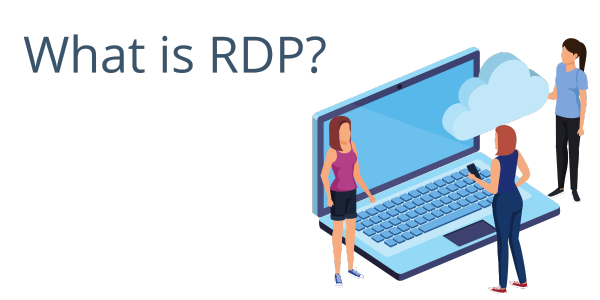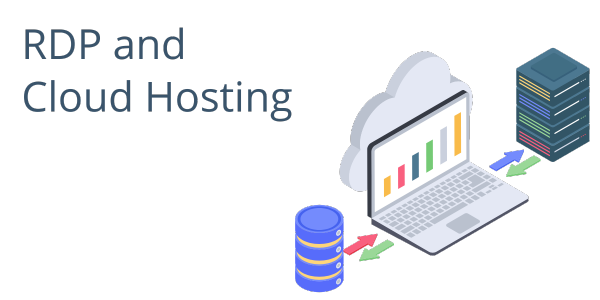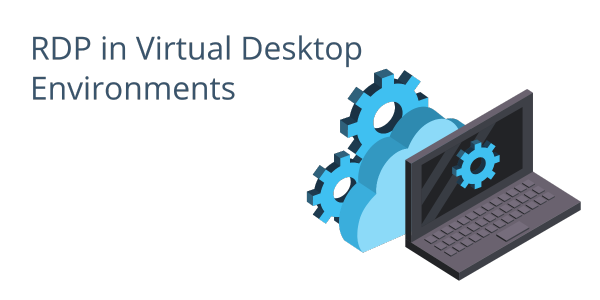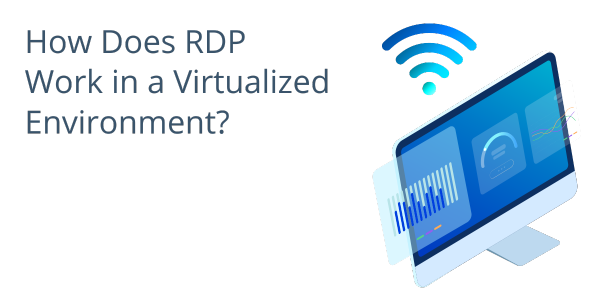
23 Aug Remote Access: How RDP Powers Cloud Hosting and VDI Solutions
Understanding how RDP creates synergy between technology and innovation in cloud hosting and Virtual Desktop Infrastructure is critical. The ability to enable remote access, secure connections, and efficiently manage computing resources allows businesses to navigate hybrid work challenges and realize the benefits of virtualization.
 What is RDP?
What is RDP?
RDP stands for Remote Desktop Protocol. It is a proprietary protocol developed by Microsoft that allows users to access and control a remote computer or virtual machine over a network connection.
In simpler terms, RDP enables users to connect to and use a computer that is located somewhere else, as if they were sitting in front of it.
 RDP and Cloud Hosting
RDP and Cloud Hosting
Cloud hosting is a modern method of managing IT resources. Instead of using physical servers, businesses use virtualization to:
- host applications
- data
- access services via remote servers provided by cloud service vendors.
This eliminates the need for businesses to invest in and maintain their hardware, providing scalability and cost savings. RDP plays a critical role in cloud hosting by facilitating secure and smooth remote access to these virtual machines.
Authorized users can connect to their designated virtual machines from any location, enhancing collaboration and enabling productivity outside the traditional office setting.
 RDP in Virtual Desktop Environments
RDP in Virtual Desktop Environments
Virtual Desktop Infrastructure (VDI) applies cloud hosting principles to individual desktop experiences. In VDI, each user’s desktop environment, including the operating system, applications, and settings, is virtualized and hosted on remote servers in a data center.
This approach offers advantages such as central management, enhanced security, and consistent desktop experiences across devices. RDP is pivotal in VDI as it enables secure remote access to these virtual desktops.
 How Does RDP Work in a Virtualized Environment?
How Does RDP Work in a Virtualized Environment?
RDP delivers each user a personalized virtual desktop experience. Regardless of the end point device, users can seamlessly connect to their designated virtual desktops while retaining applications, files, and preferences. This guarantees employees continuity in their work environment across devices which is useful for boosting satisfaction and productivity.
Similar to cloud hosting, RDP assists in centralizing the management of virtual desktop instances in VDI. It gives IT administrators the ability to remotely configure, update, and monitor all virtual desktops from one control point.
This centralized hub for remote access simplifies essential tasks like software installations, security updates, and provisioning, resulting in more efficient IT management.
RDP’s use encryption and authentication mechanisms to maintain VDI security. By securing the connection between the user’s device and the remote virtual desktop, RDP ensures sensitive data remains protected, regardless of whether your business data is accessed from external locations or from an employee’s personal devices.
Resource-sharing capabilities of RDP benefit VDI environments. Several users can connect to separate virtual desktops on the same server hardware. RDP manages the connections to isolate each session, optimizing hardware use and reducing overhead costs and long-term capital expenditures that are tied to maintaining and acquiring dedicated hardware.
In a post pandemic business landscape, VDI with RDP are catering to mobile or hybrid workforces. RDP-enabled VDI solutions grant secure access to virtual desktops from any approved device with internet access. This supports the Bring Your Own Device (BYOD) trend, allowing your employees to use their personal devices for work while still safeguarding sensitive data.
In Conclusion
Remote Desktop Protocol (RDP) serves as a bridge between stable technologies transforming how businesses operate with a remote workforce. RDP’s role in both cloud hosting and Virtual Desktop Infrastructure (VDI) offers unmatched flexibility, scalability, and productivity.
RDP allows for efficient remote collaboration, optimizing resources, and centralizing management in cloud hosting, so that remote teams can access virtual machines securely from anywhere. In VDI, RDP supports personalized digital workspaces, so you can provide a consistent user experience across devices while enabling secure remote access.
Need Help Making Your Network More Robust, Increasing Business Productivity, Or Capping Escalating Technology Costs?
Our trained team of cloud computing experts can help you by developing the most secure and efficient cloud-based storage and processing solutions for your business.
Let us demonstrate exactly what Cyberlink can do for you – using your own data and workflows.
 RDP and Cloud Hosting
RDP and Cloud Hosting RDP in Virtual Desktop Environments
RDP in Virtual Desktop Environments How Does RDP Work in a Virtualized Environment?
How Does RDP Work in a Virtualized Environment?